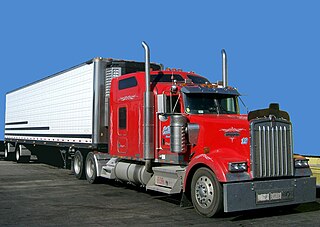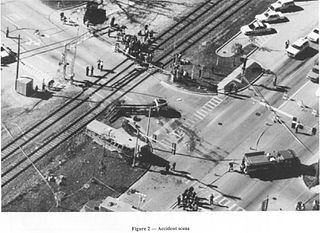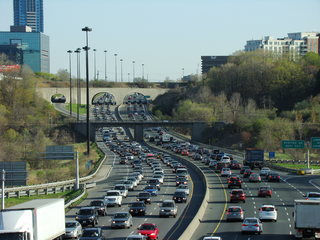
A semi-trailer truck is the combination of a tractor unit and one or more semi-trailers to carry freight. A semi-trailer attaches to the tractor with a type of hitch called a fifth wheel.

A truck or lorry is a motor vehicle designed to transport freight, carry specialized payloads, or perform other utilitarian work. Trucks vary greatly in size, power, and configuration, but the vast majority feature body-on-frame construction, with a cabin that is independent of the payload portion of the vehicle. Smaller varieties may be mechanically similar to some automobiles. Commercial trucks can be very large and powerful and may be configured to be mounted with specialized equipment, such as in the case of refuse trucks, fire trucks, concrete mixers, and suction excavators. In American English, a commercial vehicle without a trailer or other articulation is formally a "straight truck" while one designed specifically to pull a trailer is not a truck but a "tractor".

Road traffic safety refers to the methods and measures, such as traffic calming, to prevent road users from being killed or seriously injured. Typical road users include pedestrians, cyclists, motorists, passengers of vehicles, and passengers of on-road public transport, mainly buses and trams.

The Konginkangas bus disaster was a major road traffic crash on 19 March 2004, outside the village of Konginkangas in Äänekoski, Central Finland. At 02:08 local time, a bus transporting 38 passengers, most of them youths, to the Rukatunturi skiing center for an alpine ski trip crashed into a full-trailer truck carrying heavy paper rolls weighing about 61.5 tonnes total. The crash occurred on Finnish national road 4 (E75) 20 kilometres (12 mi) north of Äänekoski, and left the bus driver and 22 passengers dead; fourteen were injured. The executive director of the youth travel company was among those who perished in the crash. Most of the victims were killed immediately by the paper rolls ejected into the bus. The truck driver was uninjured.

Pacific Highway is a 790-kilometre-long (491 mi) national highway and major transport route along the central east coast of Australia, with the majority of the highway being part of Australia's Highway 1. The highway and its adjoining Pacific Motorway between Brisbane and Brunswick Heads and Pacific Motorway between Sydney and Newcastle links the state capitals of Sydney in New South Wales with Brisbane in Queensland. It approximately parallels the Tasman Sea and the Coral Sea of the South Pacific Ocean coast. Additionally, between Brunswick Heads and Port Macquarie, the road is also signed as Pacific Motorway, but has not been legally gazetted as such.

In road transport, a lane is part of a roadway that is designated to be used by a single line of vehicles to control and guide drivers and reduce traffic conflicts. Most public roads (highways) have at least two lanes, one for traffic in each direction, separated by lane markings. On multilane roadways and busier two-lane roads, lanes are designated with road surface markings. Major highways often have two multi-lane roadways separated by a median.
South Eastern Freeway is a 73 km (45 mi) freeway in South Australia (SA). It is a part of the National Highway network linking the state capital cities of Adelaide, SA, and Melbourne, Victoria, and is signed as route M1. It carries traffic over the Adelaide Hills between Adelaide and the River Murray, near Murray Bridge, where it is connected via the Swanport Bridge to the Dukes Highway, which is the main road route to Victoria.

A commercial driver's license (CDL) is a driver's license required in the United States to operate large and heavy vehicles or a vehicle of any size that transports hazardous materials or more than 15 passengers.

A truck driver is a person who earns a living as the driver of a truck, which is commonly defined as a large goods vehicle (LGV) or heavy goods vehicle (HGV).

The 1995 Fox River Grove bus–train collision was a grade crossing collision that killed seven students riding aboard a school bus in Fox River Grove, Illinois, on the morning of October 25, 1995. The school bus, driven by a substitute driver, was stopped at a traffic light with the rearmost portion extending onto a portion of the railroad tracks when it was struck by a Metra Union Pacific Northwest Line train, train 624 en route to Chicago.
The Kempsey bus crash killed 35 people and injured 41 on the Pacific Highway near Kempsey, New South Wales on 22 December 1989 when a McCafferty's Coaches coach operating an express service from Brisbane to Sydney collided head on with a Trans City Express coach operating an express service from Sydney to Brisbane. It remains the worst road crash in Australia.

Road transport is an element of the Australian transport network, and contributes to the Australian economy. Australia relies heavily on road transport due to Australia's large area and low population density in considerable parts of the country.

The Kerang train accident occurred on 5 June 2007 at about 13:40 AEST in the Australian state of Victoria, approximately 6 kilometres (3.7 mi) north of the town of Kerang in the state's northwest, and 257 kilometres (160 mi) north-northwest of the city of Melbourne.
In Canada, driver's licences are issued by the government of the province or territory in which the driver is residing. Thus, specific regulations relating to driver's licences vary province to province, though overall they are quite similar. All provinces have provisions allowing non-residents to use licences issued by other provinces and territories, out-of-country licences, and International Driving Permits. Many provinces also allow non-residents to use regular licences issued by other nations and countries. Canadian driver's licences are also valid in many other countries due to various international agreements and treaties.

A speed limit is the limit of speed allowed by law for road vehicles, usually the maximum speed allowed. Occasionally, there is a minimum speed limit. Advisory speed limits also exist, which are recommended but not mandatory speeds. Speed limits are commonly set by the legislative bodies of national or local governments.
Sunliner Express was an Australian interstate coach operator.

Terminology related to road transport—the transport of passengers or goods on paved routes between places—is diverse, with variation between dialects of English. There may also be regional differences within a single country, and some terms differ based on the side of the road traffic drives on. This glossary is an alphabetical listing of road transport terms.
Vehicle weight is a measurement of wheeled motor vehicles; either an actual measured weight of the vehicle under defined conditions or a gross weight rating for its weight carrying capacity.
Big River Way is a road in the Northern Rivers region of New South Wales that connects the Pacific Highway to the city of Grafton. It runs along a former section of the Pacific Highway that was bypassed by a newer alignment in 2020.













